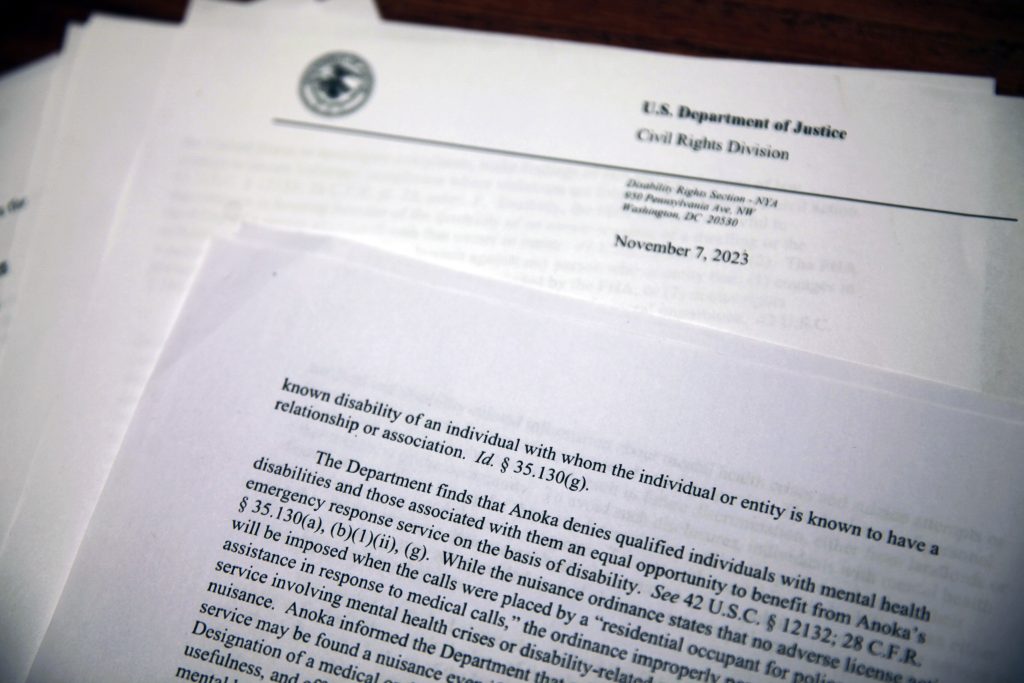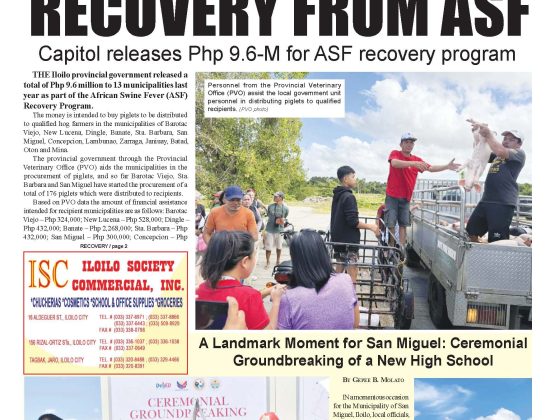Hundreds of communities across the U.S. have for several decades tried to reduce crime, fight gangs and tackle noise and other neighborhood problems through the use of “crime-free” or “public nuisance” laws encouraging and allowing landlords to evict renters when police or emergency crews are repeatedly called to the same addresses.
Long the subject of criticism that such policies are ineffective and enforced more harshly in poor neighborhoods and against people of color, the ordinances are now under scrutiny as sources of mental health discrimination.
Last November, the U.S. Department of Justice issued what it called a first-of-its-kind finding, telling a Minneapolis suburb that its enforcement of a crime-free law illegally discriminated against people with mental health disabilities.
Other cities and jurisdictions are joining a growing movement to rethink, rewrite or repeal such laws as criticism and lawsuits escalate.
WHAT ARE LOCAL ‘CRIME-FREE’ OR ‘NUISANCE’ ORDINANCES?
Anti-crime and nuisance ordinances have been around for years and are widespread in their usage. More than 2,000 cities nationwide have enacted such policies since the 1990s, according to the Chicago-based Shriver Center on Poverty Law. The International Crime Free Association says at least 3,000 international cities also use them.
Under such ordinances, landlords can be fined or lose their rental licenses if they don’t evict tenants whose actions are considered a public nuisance, including those selling drugs or suspected of other crimes. They also can be required to screen potential tenants and limit the number of people living in a home or apartment.
But every ordinance is different: unique in what it targets, how it is enforced and what kind of consequences are levied for violating it. Many also are vague about who and what is considered a public nuisance.
In Anoka, Minnesota, the Minneapolis suburb scrutinized by the DOJ, the “Crime Free Housing” ordinance covers excessive noise, “unfounded calls to police” and allowing a “physically offensive condition.” While the ordinance says a nuisance call involves “disorderly conduct,” such as criminal activity and acts jeopardizing others, it doesn’t define unfounded calls or physically offensive conditions.
Critics, and courts, say those subjective ambiguities have allowed discrimination against certain groups of people.
WHAT PROBLEMS CAN THESE LAWS POSE?
Federal fair housing laws bar landlords from asking whether someone has a disability, including a mental health disability, or refusing to rent to them on that basis. But many crime-free laws direct landlords to screen rental applicants, sometimes by the same officials who decide whether emergency calls for help or about an individual’s demeanor will count against a tenant or the landlord themself.
Some jurisdictions also share detailed information about those calls with landlords, which housing activists say is often further shared among landlords when discussing why they don’t view a past tenant as a good rental prospect.
One such law in Hesperia, California, spawned a federal lawsuit after a resident was forced to leave her home and move into a motel after calling for assistance when her boyfriend had a mental health crisis. The town’s ordinance required landlords to have potential tenants’ applications screened by the local sheriff’s office. The agency, according to the lawsuit, then shared with landlords a list of people it flagged as potentially troublesome renters.
Advocates say reluctance to rent to people previously hospitalized for mental health issues, as well as city policies that discourage renting to people who have been arrested, exacerbates the situation.
People face being homeless or “forced to cycle from an institution to a homeless shelter,” said Corey Bernstein, executive director of the National Disability Rights Network.
A lack of community services often means jails serve as “de facto psychiatric centers” for people with mental illnesses, said Devon Orland, litigation director at the disability rights Georgia Advocacy Office.
“We’ve seen people on street corners yelling or getting upset,” Orland said. “That locality doesn’t want them around and then they reappear or they don’t leave immediately and they get arrested for criminal trespass.”
WHERE ARE THE LAWS MOST OFTEN ENFORCED?
Critical studies and lawsuits indicate enforcement of nuisance laws frequently occur in poorer neighborhoods and communities of color.
An August 2018 report from the American Civil Liberties Union and New York Civil Liberties Union said data from Rochester and Troy, New York, showed the most vigorous enforcement of “no crime” and “public nuisance” laws occurred in poor and heavily minority areas.
A 2017 federal lawsuit against Peoria, Illinois, similarly plotted three years’ worth of data on a map of the city and found almost all nuisance citations were issued in neighborhoods with larger percentages of residents of color.
Other studies and lawsuits indicate such ordinances are typically in response to an influx of residents of color, often from larger communities such as Cleveland or Los Angeles.
When the DOJ sued Hesperia, a city of about 101,000 residents about 60 miles (97 kilometers) northeast of Los Angeles, in 2019, the agency said officials there had made it clear their ordinance was a reaction to an increasing number of residents of color.
The lawsuit quoted one council member saying “those kind of people” coming from the Los Angeles area were of “no value” and “I want their butt kicked out of this community as fast as I can possibly humanly get it done.”
Other lawsuits have concluded crime-free policies hurt domestic abuse victims for repeatedly calling for help from police.
The U.S. Department of Housing and Urban Development filed a complaint in 2013 against the Philadelphia community of Norristown, Pennsylvania, over an ordinance it said allowed the town to sanction landlords over “domestic disturbances that do not require that a mandatory arrest be made.”
A Black resident had filed a federal lawsuit over a series of 2012 incidents involving an abusive boyfriend. She was told by police that she faced eviction over the emergency calls and later did not call police after her boyfriend stabbed her in the neck. A neighbor called police and the woman was airlifted to a hospital for emergency care, the lawsuit said.
WHERE ARE THESE LAWS BEING CHALLENGED?
At least a few states are trying to limit the reach of such ordinances.
Maryland last year prohibited cities and counties from penalizing landlords and now prevents landlords from evicting tenants over the number of police or emergency calls to their addresses. At the start of this year, California greatly limited cities’ use of crime-free policies. Advocates expect a similar push for such legislation in Illinois.
Housing advocates and civil liberties groups also have challenged ordinances in multiple states, including California, Illinois, Ohio and Pennsylvania, forcing cities to rewrite or repeal their ordinances in legal settlements.
Some communities have backed off on their own.
In the Minneapolis area, the communities of Golden Valley, St. Louis Park and Bloomington repealed most or all of their ordinances starting in 2020.
Other area cities have rewritten their ordinances, including Faribault in 2022 as it agreed to pay $685,000 to settle a federal lawsuit over the law.
___
Hanna reported from Topeka, Kansas.


